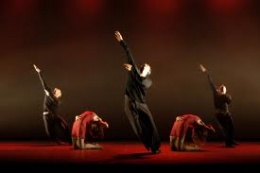Also known as modern dance , it is a style created to express feelings. Just as feelings change, contemporary dancers must constantly change. Individualism, abstraction and dedication to art are important .
The dancers have little in common other than a rejection of existing traditions and a desire to re-examine the fundamental principles of dance as a means of communication. Currently there are two techniques: the Graham, and the Cunningham, but contemporary dancers often mix them up.

History
Its history can be defined in three periods:
1900 : Period marked by the free movements of the dancers Isadora Duncan , Ruth Saint Denis and Mary Wigman , who sought to give dance a more communicational sense, relying on sources of inspiration older than those of the West.
1930 : The second wave of modern dancers emerged in New York , including Martha Graham , Doris Humphrey, and Charles Weidman . For these dancers, the source of movement was more internal than external, resorting to natural actions such as breathing or walking.
1945 : This period began at the end of World War II and is still valid today. Dancers such as Alwin Nikolais , Merce Cunningham , among others, fused techniques from social dance, ballet and modern dance.
General characteristics
This dance is one hundred percent interpretive, its movements are synchronized with the head trying to communicate a message. Expand the range of motion, and use the space with greater possibilities. A distinctive feature is the use of multimedia to accompany the choreographies , such as video and images used in the background.
Techniques
Graham
Created by Martha Graham in 1927 , who studied at Denishawn School. In his technique the important thing is to feel the movements. It is divided into floor, center and movement work. It is characterized by muscle contraction and relaxation to produce motor energy , playing with one’s own body weight, and contrasting closed and open positions. Among its characteristic movements are the demi-pliés with parallel feet, the triplettes and the shoulder falls.
Cunningham
Created by dancer Merce Cunningham , who parted ways with Graham’s company to create his own. He is the only person who teaches this technique in a pure way since he has not written his exercises. It is emphasized in an upright position and graceful legs and arms. He uses many exercises with demi-plies and exercises where the foot is pointed out in different directions.
Differences with ballet
Ballet
The shapes are always funny and beautiful.
The body needs to have a particular shape and from childhood we work on that.
High movement and jumps are worked.
The basic steps are rigidly defined
The choreography follows a story and has several characters.
It is danced with special clothes and shoes.
Contemporary dance
The shapes show the beauty and the ugliness of life
The body can weigh or measure anything as long as it is strong and flexible.
It works on the ground and in falls.
There are many styles of steps
Choreography is based on ideas and feelings.
You dance with whatever clothes are. They usually dance barefoot.
The classical dance has a drama with a beginning, climax and denouement. Contemporary dance can follow this structure or tell stories in a non-linear way. Contemporary dance can talk about a concept, propose an environment or present movements with the purpose of achieving a certain aesthetic, it does not always have to tell a story.
On the other hand, classical dance is built through already existing and always codified steps while contemporary dance seeks innovation and the creation of new forms of movement according to the needs of the choreographer or performer .
Classical dance seeks preciousness, the structured and perfect, the connection with the ethereal, with the celestial; rather it is linked to the concept of the Apollonian. Contemporary dance seeks the connection with the earthly, with the human and its passions, the non-structure, the transgression; it is linked to the concept of the Dionysian.
Pioneers of Modern Dance
Isadora Duncan :
It gave rise to movement through Greek sculpture. She preferred to dance barefoot, leaving aside the conventional and classic ballet shoes. He wore a simple robe as an outfit. He located the origin of the movement in the solar plexus chakra and created dances in which resistance and abandonment to the law of gravity alternated.
Ruth Saint Denis :
His compositions were based on the style of the dances of India, Egypt and Asia. She began her career as a solo dancer, later forming the Denishawn Company with her husband Ted Shawn.
Mary Wigman :
His choreography was inspired by the Asian and Eastern world. In his works, whether in a group or as a soloist, he used masks many times.
Martha Graham :
His technique was based on the relaxation and contraction of the breath (inhale and exhale). His early works were quite abstract since they focused on body movements, such as the one initiated in the torso. Later creations and performances narrated mystical and psychic themes.
Doris Humphrey :
His technique was based on the fall and recovery of the natural dynamics of the human footprint and the influence of the force of gravity. The humorous dances, of social content and of musicals were present in their repertoires, taking gestures and words as choreographic sources instead of their experiences obtained in the investigation of the movement.
Merce Cunningham :
He located the movement in the spine and caused a revolution by mixing Graham’s technique with traditional ballet.
